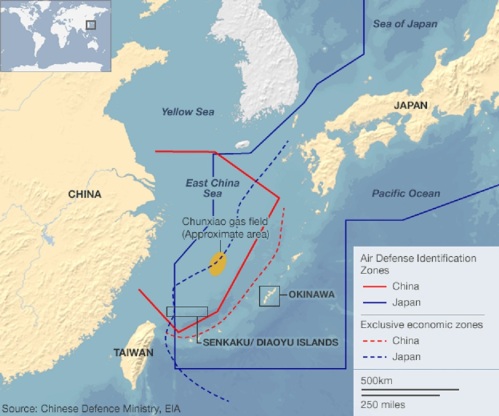 Christopher Bodeen reports for the AP, Nov. 28, 2013, that days after the U.S., South Korea and Japan all sent flights through the airspace unilaterally declared last Saturday by China as its East China Sea Air Defense Identification Zone (ADIZ), China today said it had sent warplanes into the ADIZ.
Christopher Bodeen reports for the AP, Nov. 28, 2013, that days after the U.S., South Korea and Japan all sent flights through the airspace unilaterally declared last Saturday by China as its East China Sea Air Defense Identification Zone (ADIZ), China today said it had sent warplanes into the ADIZ.
China’s ADIZ overlaps with Japan’s over the Senkaku or Diaoyu islands, the ownership of which is claimed by both Beijing and Tokyo.
China’s air force sent several fighter jets and an early warning aircraft on normal air patrols in the zone, the Xinhua agency reported, citing air force spokesman Shen Jinke. Shen described Thursday’s flights as “a defensive measure and in line with international common practices.” He said China’s air force would remain on high alert and will take measures to protect the country’s airspace.
The report did not specify exactly when the flights were sent or whether they had encountered foreign aircraft. The United States, Japan and South Korea said they have sent flights through the zone without yet encountering any Chinese response.
Analysts say Beijing’s motive in declaring the ADIZ is not to trigger an aerial confrontation but is a more long-term strategy to solidify claims to disputed territory by simply marking the area as its own.
China’s lack of efforts to stop the foreign flights – including two U.S. B-52s that flew through the zone on Tuesday – has been an embarrassment for Beijing. Even some Chinese state media outlets suggested Thursday that Beijing may have mishandled the episodes.
“Beijing needs to reform its information release mechanism to win the psychological battles waged by Washington and Tokyo,” the Global Times, a nationalist tabloid published by the Communist Party’s flagship People’s Daily, said in an editorial.
Last Saturday, Nov. 23, 2013, without prior notice, Beijing began demanding that passing aircraft identify themselves and accept Chinese instructions or face consequences in an East China Sea zone that overlaps a similar air defense identification zone overseen by Japan since 1969 and initially part of one set up by the U.S. military.
But when tested just days later by U.S. B-52 flights – with Washington saying it made no effort to comply with China’s rules, and would not do so in the future – Beijing merely noted, belatedly, that it had seen the flights and taken no further action.
South Korea‘s military said Thursday its planes flew through the zone this week without informing China and with no apparent interference. Japan also said its planes have been continuing to fly through it after the Chinese announcement, while the Philippines, locked in an increasingly bitter dispute with Beijing over South China Sea islands, said it also was rejecting China’s declaration.
Analysts question China’s technical ability to enforce the zone due to a shortage of early warning radar aircraft and in-flight refueling capability. However, many believe that China has a long-term plan to win recognition for the zone with a gradual ratcheting-up of warnings and possibly also eventual enforcement action. All of which may wear down Japan and change the status quo.
The zone is seen primarily as China’s latest bid to bolster its claim over a string of uninhabited Japanese-controlled islands in the East China Sea – known as Senkaku in Japan and Diaoyu in China. Beijing has been ratcheting up its sovereignty claims since Tokyo’s privatization of the islands last year.
But the most immediate spark for the zone likely was Japan’s threat last month to shoot down drones that China says it will send to the islands for mapping expeditions, said Dennis Blasko, an Asia analyst at think tank CNA’s China Security Affairs Group and a former Army attache in Beijing.
China’s defense and foreign ministries offered no additional clarification Thursday as to why Beijing failed to respond to the U.S. Air Force flights. Alliance partners the U.S. and Japan together have hundreds of military aircraft in the immediate vicinity.
China on Saturday issued a list of requirements for all foreign aircraft passing through the area, regardless of whether they were headed into Chinese airspace, and said its armed forces would adopt “defensive emergency measures” against aircraft that don’t comply.
Beijing said the notifications are needed to help maintain air safety in the zone. However, the fact that China said it had identified and monitored the two U.S. bombers during their Tuesday flight seems to discredit that justification for the zone, said Rory Medcalf, director of the international security program at Australia’s Lowy Institute. “This suggests the zone is principally a political move,” Medcalf said. “It signals a kind of creeping extension of authority.”
Along with concerns about confrontations or accidents involving Chinese fighters and foreign aircraft, the zone’s establishment fuels fears of further aggressive moves to assert China’s territorial claims – especially in the hotly disputed South China Sea, which Beijing says belongs entirely to it.
Chinese Defense Ministry spokesman Yang Yujun confirmed those concerns on Saturday by saying China would establish additional air defense identification zones “at an appropriate time.”
For now, however, China’s regional strategy is focused mostly on Japan and the island dispute, according to government-backed Chinese scholars. Shen Dingli, a regional security expert and director of the Center for American Studies at Shanghai’s Fudan University, says China will continue piling the pressure on Tokyo until the latter reverses the decision to nationalize the islands, concedes they are in dispute, and opens up negotiations with Beijing.
Shen said, “China has no choice but to take counter measures. If Japan continues to reject admitting the disputes, it’s most likely that China will take further measures.”

